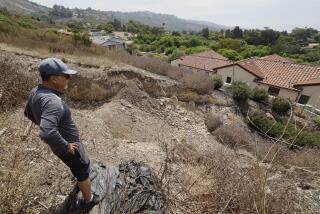High Tension : Concerns about potential for health risks make homes near power lines hard or impossible to sell
Mark McCartin is a successful doctor. But his life is no longer adorned with the cushy trappings of a well-paid physician. The 4,500-square-foot San Clemente home with 180-degree ocean views is gone and so is his once-impeccable credit rating.
These days, when his shift at the Harbor City Kaiser Hospital emergency room ends, McCartin retires to his stark quarters at a nearby Motel 6. Once a week, he drives the 600-mile, round-trip commute to spend time with his wife, Cheryl, and five children. The family now lives full-time, squeezed into a quarter of the living space, in what used to be the McCartin vacation home in Bass Lake, near Yosemite.
The McCartins abandoned their dream home in June, 1994. Their reason: to protect their children from the what they saw as the health hazards posed by the high-voltage power lines strung behind the back fence.
A number of scientific studies suggest electromagnetic fields (EMFs), which emanate from electrical currents that flow through power lines and all electrical circuits, might cause such deadly diseases as childhood leukemia, lymphoma and brain cancer.
“I treat kids with leukemia in the emergency room all the time and I wasn’t about to risk my kids,” said McCartin, who along with 22 other neighbors filed an unsuccessful lawsuit against the San Diego Gas & Electric Co. for the lost value of their homes. “We tried to sell the home for three years. We dropped the price from $830,000 to $539,000. . . . Finally in June (1994), after we lost the lawsuit, I just left the house and quit making payments.”
The EMF issue has raged in the scientific community for the past 16 years. A number of studies have found children living near certain high-voltage power lines are more likely to develop leukemia. Subsequent epidemiological and laboratory studies have shown contradictory results. Some have indicated strong evidence of health hazards posed by EMFs and others have found no link.
The inconsistencies have done little to quiet public fears, which in turn are affecting property values nationwide. Many houses near power lines, such as the McCartins’, have become difficult to sell. Others that do sell, often go for far less than similar homes situated away from the lines.
“I’ve heard from so many people trying to sell their homes who say real estate agents aren’t coming to their house because of the power lines,” said Louis Slesin, editor of Microwave News, a New York City-based newsletter that pioneered reporting on the health risks of EMFs. “It isn’t easy to sell anymore.”
In 1986, Microwave News published a story in which a number of health experts were asked if they would buy a house next to a power line that sold for $25,000 less than an equal house.
“When a senior EPA official said he wouldn’t do it, that was the opening shot in the debate,” Slesin said. “ . . . There is so much money at stake here.”
Indeed, some public policy analysts have estimated that lower property values caused by EMF concerns, increasing EMF lawsuit expenses and higher electricity rates are together costing $1 billion a year nationwide.
Karen Johanson, a mortgage broker and owner of San Diego-based Johanson & Associates, said that, increasingly, there is a “substantial difference in price” between homes near high-voltage power lines and those farther away.
Johanson said it isn’t just the buyers who are fearful. “We’re now seeing the appraisers are taking it into consideration when they do an appraisal,” she said.
“For instance, if there are [high-tension] power lines on one side of the street, they can’t use the houses on the other side of the street as a comparable. You have to have at least one comp along the power lines.”
EMFs exist whenever an electrical current passes through a wire--be it in a household appliance, such as a refrigerator motor, a computer screen, clock radio--or in a power line, which, depending upon where it is in the power distribution system, can carry up to several hundred kilovolts of electricity.
The concern about EMFs stems from the magnetic portion of the electric fields, which are measured in units called, “gauss” or, more commonly, the “milligauss” (mG).
The stronger the electrical current, the stronger the magnetic field. The intensity of the field drops sharply the farther one moves away from it.
Although the electric portion of those fields can be shielded, the magnetic fields penetrate concrete, soil, walls and other solid objects without losing intensity.
The magnetic field level inside a particular home depends on any number of factors, including the electrical appliances in use at the house at any given time, as well as the home’s wiring and the proximity of the house to outside power lines.
The typical home averages about .7 mG, according to Southern California Edison Co., and between .1 to 2 mG, according to other studies. Levels of 2 mG and above were found to double the risk of leukemia in children, according to a 1992 Swedish study considered among the more careful research on the issue.
But Jack Sahl, senior research scientist for Edison, cautioned against jumping to conclusions about the dangers of EMFs.
“I’m concerned that people who are worried about issues like electromagnetic fields will inappropriately change their priorities about their health and well being,” Sahl said. “We don’t have the luxury to ignore things that are established health problems. . . . [But] I think we have to give the scientific community the time it takes to address and resolve the problem.”
Further, Sahl argues that despite the public fear, there is as of yet no justification for making the costly, massive changes required to modify the nation’s complex electric power system.
Among the modifications that can reduce magnetic fields is reconfiguring overhead and underground power lines so that they’re closer together, which causes the magnetic fields to partially cancel one another out. But such efforts would carry an enormous price tag, which utility officials say is too much for an unproven threat.
Critics of that position, however, say society can’t afford to wait for perfect science before public policy is established.
“In the meantime, we have to look at how we’re inadvertently creating a victim class,” said Ellen Stern Harris, executive director of the Fund for the Environment, a Beverly Hills-based nonprofit organization that promotes the protection and restoration of California’s environment through research and education. “People are being involuntarily exposed.”
Part of the difficulty in establishing definitive information regarding the effects of EMFs is that nearly everyone is exposed to electromagnetic radiation. Further, it’s not known what role the earth’s naturally occurring magnetic field has on us or how it may interfere with study results.
And, if there is an EMF danger, is it caused by short-term exposures to high EMF levels one could experience by walking under high-tension power lines? Or is long-term, chronic exposure at low levels more hazardous? Numerous studies at the state, national and international level are underway in an effort to answer these difficult questions. So far, however, the only certainty seems to be the growing public fright about the potential EMF health threat.
“They don’t care about the uncertainty [in study results],” Slesin said of many home buyers who are familiar with the EMF controversy. “Especially if they have children, they’re saying, ‘I don’t want to take the risk.’ ”
Said realtor Debbie Van Leeuween of Mulhearn Realtors in Lakewood:
“If I show a house that’s under the power lines or backed up to them, [clients] will often say they don’t want to be in a house that’s near power lines. A lot of times I’ll say, ‘May I ask why?’ And they’ll say they’re just afraid of the unknown and they’d rather not look at it. That obviously hurts the seller . . . because to sell it, they have to bring down the price.”
Jim Sullivan, a resident of Bellflower, is ready to move out of his rental and buy. But, he says, he won’t consider a home backed up to the high-tension power lines that traverse the area.
“I’m scared of them,” he said. “They’re coming up with more things all the time about them in the news, so I don’t trust them.”
On the opposite end of the spectrum is the hopeful home seller backed up to power lines.
“It’s nice because no one lives behind me,” Clint Chambers, a manager at an aerospace firm said of the high-tension power lines that back his Lakewood home. “We can use the space behind our house for a garden and we only have neighbors on two sides, instead of being cornered in.” But Chambers’ wife, Susan, has a different perspective.
“I’m not completely at ease with it and I do sometimes feel like this is not where we should be,” she said. “If I were to buy another home, I wouldn’t buy by the power lines. I have three friends who live by the power lines and have breast cancer. . . . My husband tells me I’m paranoid, but what if I’m not?”
Stern Harris says that question can no longer go ignored. “My feeling is until the findings are concurred by the various principles in the scientific community, we’ve got to protect the economic well-being of those who are buying homes, or those who are staying in homes where power is being changed,” she said.
“For example, the [utility company] could decide to double the amount of power going through the lines where you live. They don’t have to announce it to you, and you don’t have a voice in it.” But the question of what kind of EMF policy should be formulated in this state of confusion isn’t easily answered.
The City of Irvine is among a small, but growing number of local governments that has addressed the issue. In 1992, city officials approved a policy that requires a certain setback for “sensitive” land uses--such as residential and day-care facilities, said Robert Johnson, director of community development for the city.
And the State Department of Education urges school districts to adopt a conservative approach when reviewing potential school sites near power transmission line easements.
Stern Harris, who served on a California Public Utilities Commission (PUC) EMF consensus group and has led efforts to inform the public about potential EMF hazards, said that, at the very least, the utilities should notify residents and provide environmental impact reports (EIRs) whenever they increase the flow of power through lines. But utility officials say that’s impractical.
“EIRs are designed to respond to public health concerns where there is some larger degree of evidence that there is a real concern,” said Sahl, the Edison scientist. “To produce an EIR and get neighborhood approval to [make changes to the electrical system] would be an extraordinary waste of resources and a huge distortion of public health policy.”
Slesin, of Microwave News, said that increasingly courts are allowing property owners to recover damages from utilities for property value losses caused by EMF “cancerphobia” fears.
“It matters when people believe it,” said Slesin. “That makes imminent sense to me because the final judgment is how many dollars are on the table when you sell your house, not whether power lines and EMFs are a potential cancer risk.”
McCartin and his family agree.
After he stopped paying the $3,500 monthly mortgage payment on his former house, McCartin’s excellent credit rating plummeted and now the family is considering bankruptcy. Still, McCartin said, no amount of money could buy the peace of mind he and his wife have since they left their dream home behind.
“It’s money and that’s life,” McCartin said matter-of-factly, just days before the bank officially foreclosed on his home. “ . . . Our kids are still healthy and that’s the bottom line.”
Stephanie O’Neill is a Los Angeles free-lance writer.
(BEGIN TEXT OF INFOBOX / INFOGRAPHIC)
EMF Exposure Levels
Exposure to EMF fields, measured in milligauss units (mGs), varies according to proximity to the source of the field. Table below lists the exposure levels based on voltage and distance.
Electrical Power Lines
Types of Distance from lines transmission lines 50 feet 100 feet 200 feet 115 Kilovolts Average usage 7 mGs 2 0.4 Peak usage 14 4 0.9 230 Kilovolts Average usage 20 7 1.8 Peak usage 40 15 3.6 500 Kilovolts Average usage 29 13 3.2 Peak usage 62 27 6.7
****
Household/Office Sources
The following tables show the strength of EMFs produced by some common appliances. The typical American home has a background magnetic field level ranging from 0.5 to 4 mGs.
Type of Distance appliance 6 inches 1 foot Hair Dryer 300 mGs 1 Electric Shaver 100 20 Blender 70 10 Can Opener 600 150 Dishwasher 20 10 Garbage Disposal 80 10 Microwave Oven 200 40 Mixer 100 10 Vacuum Cleaner 300 60 Analog Clock n/a 15 Baby Monitor 6 1 Copying Machine 90 20 PC (color monitor) 200 70 Electric pencil sharpener 14 5
Source: U.S. Environmental Protection Agency
More to Read
Sign up for Essential California
The most important California stories and recommendations in your inbox every morning.
You may occasionally receive promotional content from the Los Angeles Times.









